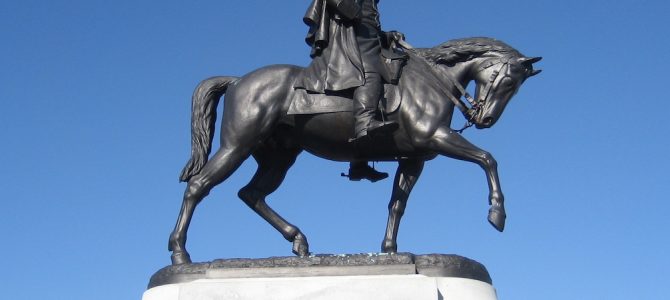
In the early morning hours of Monday, masked men in black bulletproof vests gathered at the Battle of Liberty Place in downtown New Orleans. They arrived in flatbed trucks, the name of the company on the trucks’ sides concealed by tape and cardboard. Snipers took up positions on nearby rooftops.
This wasn’t the scene of a bank heist or a mob hit. The snipers were New Orleans police, and the workers were under contract with the city. They were there to tear down a 126-year-old monument linked to the Confederacy. New Orleans is the latest city to embark on the removal of its Confederate monuments, a rising trend among progressive municipal leaders and activists who claim to be acting in the name of tolerance but whose true purpose is political.
By dawn on Monday, the first of four monuments to be removed, a white marble obelisk on Canal Street, was gone. The city went about the removal amid an air of official secrecy and heightened security measures in response to threats against the city’s contractor earlier this year. New Orleans Mayor Mitch Landrieu issued a statement at 3:15 a.m. Monday, while crews were still at work, saying the removal “sends a clear and unequivocal message” about the city’s focus on celebrating “our diversity, inclusion and tolerance.”
Because nothing says inclusion and tolerance like tearing up century-old monuments and carting them off in the dead of night.
Tearing Down Statues Is Always About Politics And Power
The push to remove Confederate statues and monuments has gained traction in the wake of the racially motivated Charleston church shooting in 2015 that left nine African Americans dead. South Carolina’s legislature and then-Gov. Nikki Haley made the wise and prudent decision to remove the Confederate flag from the statehouse grounds in Columbia, where it had been flying on a Confederate war memorial since 2000. Before that, it had flown atop the capitol dome beginning in 1961, in defiance of the civil rights movement.
But it didn’t end there. Almost immediately, colleges and municipal governments across the South began efforts to remove Confederate memorials, rename schools and public spaces bearing the names of Confederate leaders, and in some cases even exhume the remains of Confederate dead. Although this trend is relatively recent, the impulse to destroy monuments is very old.
In ancient Rome, it was called damnatio memoriae, the “condemnation of memory,” and its purpose was overtly political. The point was to dishonor traitors and deposed emperors by purging them from public memory. Rome would seize their property, remove their name from public monuments, and destroy or re-work their statues.
Today, the practice has been revived, albeit under the pretext of inclusion and tolerance. The University of Texas at Austin removed a statue of Jefferson Davis from the school’s historic mall in August 2015. It now resides at UT’s Briscoe Center for American History. Last fall, Texas State University in San Marcos quietly removed a statue of Jefferson Davis and sent it seven miles south of town, to private land donated to the United Daughters of the Confederacy. Similar efforts by cities have cropped up in Virginia, Kentucky, South Carolina, and elsewhere.
Not all of them have been successful. In August 2015, the Memphis City Council voted to remove a statue of Nathan Bedford Forrest, along with the remains of Forrest and his wife, from a park near downtown Memphis. But the Tennessee Historical Commission stepped in, citing a state law passed in 2013 that prevents cities and counties from relocating, removing, or renaming war memorials on public property.
A handful of states have such laws on the books, and if the past few years are any indication, they’re the only thing preventing the destruction or removal of Confederate memorials in dozens of southern cities.
This Is Not About Honoring Confederate Principles
Plenty of Americans would like nothing more than to see them go. They ask, why shouldn’t we get rid of these monuments? After all, the Confederacy was a rebellion of slave states that cost the lives of some 620,000 Americans and left the country shattered. If it was right to remove the Confederate flag from the statehouse in South Carolina, why not the statues and obelisks?
There is good reason to leave the monuments where they stand, but let’s be clear. The reason for keeping them has nothing to do with honoring the cause of the Confederacy or the memory of slavery. Even though many of them were erected for that purpose in the decades spanning the 1870s to the 1930s, that should not be our purpose for keeping them now.
The case for keeping our Confederate monuments has everything to do with preserving our history, the better to understand it. The history of the Civil War and the Confederacy is complicated and, even to this day, painful for some Americans. But a standing monument isn’t the same as a flag flying in a place of honor. Monuments become part of our landscape down through the decades, and their physical presence testifies to the past in a way that museums cannot.
This is especially true of our Civil War monuments. Something as central to American history as the war between North and South should impose on us and demand our attention—not so that we can honor the principles of the Confederacy, but so we can understand and remember who we were and all we suffered to survive the Civil War and remain one nation.
Progressives claim a special prerogative to purge our public spaces of disfavored symbols and monuments, whether of the Confederacy or other historical figures whose views are now offensive by contemporary standards. It’s not enough, they say, to add plaques that give greater historical context or add Unionist monuments alongside Confederate ones. That should tell you something.
The drive to erase the Confederacy from our public squares isn’t really about unity or tolerance. It’s about power and politics. Censoring historical symbols is after all the cousin of censoring speech and inquiry. Hence the spectacle of Mayor Landrieu explaining how the Confederacy was “on the wrong side of history,” even as he rips up historical monuments in the name of progress.
At a time when the divisions in our country are deepening, and Americans are sorting themselves into increasingly hostile factions, we could do worse than to gaze on Confederate statues, contemplate their reasons for fighting, and consider what it took to put the country back together.









